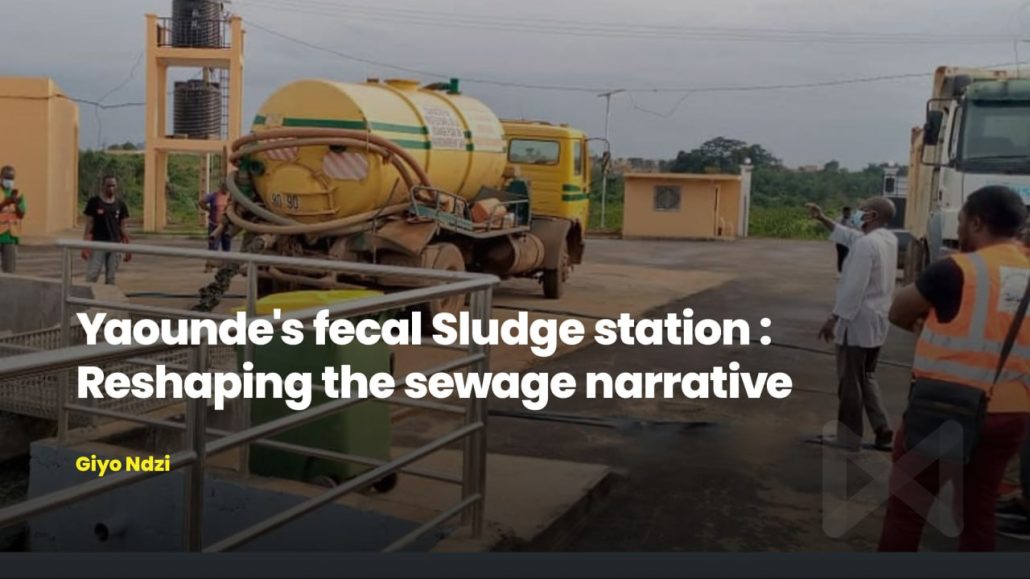In May 2023, cholera cases in Yaounde peaked, with the capital city reported at some point to have recorded up to 50 cases daily. Among primary causes of this disease, are polluted water sources and contaminated foodstuff. The epidemic is just one of many other challenges staring the capital city in the face, owing to poor hygiene and waste disposal.
In a city like Yaounde, one would expect the situation to be better. Conversely, the town is known for its muddy streams and dry taps even in high-end neighborhoods.
“Waste disposal in Yaounde is increasingly becoming an alarming environmental challenge. The numerous open dumpsites scattered all over the city demonstrate the dire need to adopt better and more effective waste management practices,” explains environmental engineer and climate activist, Patu Ndango.
“There are limited number of solid waste management companies in Yaounde just like in most other big cities in Cameroon. This sector has been highly monopolised reason why there is little or no competition thus the high level of mediocrity observed,” she adds.
The adverse effects of this poor waste and fecal sludge disposal in particular, are far reaching. Patu believes this stems partly from laxity with construction regulations. In Yaounde, she says, “houses and consequently toilets are built without any proper planning. Little or no consideration for the underground water which constitutes a major source of water for most households. Thus the possible contamination of such water sources from sewage that finds its way in it.”
Sewage collection truck travelling across town (Photo: Giyo Ndzi)
“We also have a lot of fecal matter which gets washed away into surface water bodies from the numerous improperly built toilets we find around Yaounde especially in ghetto neighbourhoods.” Sewage can contaminate water sources and ecosystems, causing diseases, eutrophication, algal blooms, fish kills, coral bleaching, and biodiversity loss.
In addition to the adverse environmental and health risks, the environmental engineer and climate activist notes that this state of affairs is also a blow to the city’s aesthetic capabilities.
Waste truck empties collected sewage at Etoa treatment plant (Photo: Desire Ahanda – CUY)
As humans, producing waste – in this case, sewage – is inevitable. But adequate management is a reality. It is with this fact in mind that the Yaounde City Council is seeking to turn the tide in its favour. It operates a faecal sludge treatment plant was created, administered through its Department of Water and Sanitation. Located in Etoa at the western entrance to the city, it was constructed with funding from the Bill and Melinda Gates Foundation, and the International Association of Francophone Mayors (AIMF). Covering a surface area of 2.5 hectares, it was inaugurated in September 2021.
Milking the mud
When the waste arrives the plant, the first step is to filter out any solid matter. “Even in our modern septic tanks we find solid waste… when it arrives here we take out time to filter that out. Once that is done it goes to the filtration basin we have there. It is 5 meters deep composed of moving sand,” explains Mr Sezawo Raymond, Supervisor of the Fecal Sludge Treatment Station.
Mr Sezawo Raymond (Photo: Desire Ahanda – CUY)
He adds: “When it gets there it is stratified in three layers. At the bottom there is the fecal matter. In the middle there is water and at the top, light material floating on water.”
From the first filter, the liquid waste is then channeled through a second filter – a quick sand bed – which slowly extracts the finer liquid for a period of 10 days. This same liquid is then sent to bigger sand beds by use of pumps goes through to the main sand beds where it is left to drain more naturally and solidify. The station hosts 18 drying beds.
They are then left to harden, as the sand beds sieve the waste into different factions, eliminating impurities. The entire process takes a total of two to three months, depending on a range of factors including atmospheric humidity and the quantity of waste being processed.
100 meter cubic basin containing final product of liquid (Photo: Desire Ahanda – CUY)
The final products from the weeks-long process, are solid and liquid. The liquid all drains into a 100 cubic meter basin where it stands for as long as two weeks. The bacteria found in this basin,” Mr Sezawo notes, “feed on the little impurities left in the liquid before it drains out. The longer it stands here, the more they feed on it. This is why it is important for the water to stay for as long as possible before being ejected.”
It has to stay in this basin for 10 days and in the best case scenario, two weeks. But when it spends only a week, it is normal for the quality going out to not be as good as it should. “The objective is not necessarily to have potable water, but to have a liquid void of pollution which can be sent into nature without harming the environment. That is the objective. So even when it is in the state, we have eliminated about 90% of that waste from it,” he adds.
Sludge extracted from sewage (Photo: Desire Ahanda – CUY)
The solid waste – sludge – is moved to a store room where some of it is ground and applied to farms as manure. This final matter can also be a source of renewable energy and valuable resources, such as biogas, biofuel and fertilizer. These products can help reduce greenhouse gas emissions and environmental pollution by replacing fossil fuels and synthetic chemicals. They too can be a viable source of income, bringing in millions.
The Achilles heel
From a general view, the plant is a huge success, a turning point in Yaounde’s waste story. But it is not without its own impediments. “The fecal matter management plant in Yaounde is practically the only existing sewage treatment facility in such a big city,” Patu notes.
“The station was made for a treatment of 265 meters cube daily but these days we get to a capacity of 300 metres cube daily and at times we peak to 500 cubic meters,” confirms Yannick Atangana, head of the Department of Water and Sanitation at the Yaounde City Council. He adds that the excess, “has a consequence on the quality of treated matter which leaves the station… when this is interrupted the quality is no longer the best.”
In addition to this, the final output of the plan is yet to be utilized in large scale. A visit to the structure reveals recycled waste matter lying around in heaps, unutilized. Suitable for manure, it can also be utilized for other beneficial purposes too including as dry-combustion fuel or charcoal. But many find it hard to accept the end products.
Patu explains: “much still needs to be done to improve the acceptability of the resulting bio fertiliser from this plant … a lot of education and sensitisation campaigns need to be carried out to not only raise awareness about the existence of such a facility and its role but also, to be encourage people to the adopt the use of the end product – bio fertilizer – from this plant”
Manure, final produce from sewage (Photo: Desire Ahanda – CUY)
These challenges, city officials note, have been taken into account and are being addressed gradually. “We are seeking other more adaptable solutions but it is a challenge we are taking seriously,” Yannick Atangana explains.
Sewage has a complex and dynamic link with the environment and the climate. Much like a weapon, its appreciation rests entirely on how it is treated. Maximising its positive consequences entails a conscious effort by the powers that be to develop and implement adequate sanitation policies and regulations at local, national, and international levels.
Patu recommends a two-fold solution that implicates both public and private actors. The powers that be, she advises, should “encourage and introduce more competitive companies with innovative solutions to tackle waste collection, transportation and treatment, [and] decentralise waste management to the council levels and introduce incentives for the councils with the most effective waste management strategies”
This warrants among others, investment in appropriate sewage infrastructure and technologies that suit the local conditions and needs. Yaounde counts over 4 million people and one sewage treatment plant will never be enough. Commendable as the effort is, it remains a first step in what remains a whole journey. Denizens of the town can only hope that subsequent steps are taken and fast.
Giyo Ndzi



